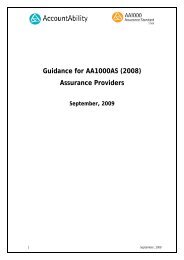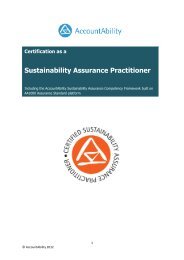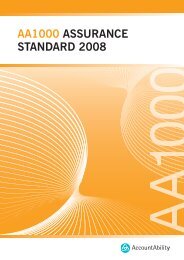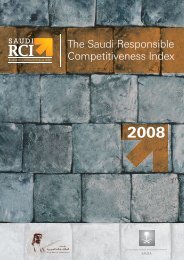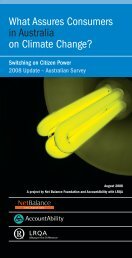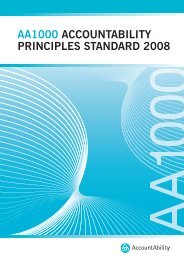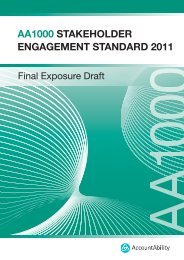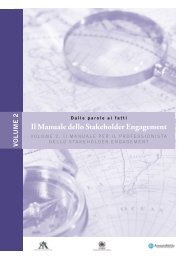The Stakeholder Engagement Manual Volume 2 - AccountAbility
The Stakeholder Engagement Manual Volume 2 - AccountAbility
The Stakeholder Engagement Manual Volume 2 - AccountAbility
Create successful ePaper yourself
Turn your PDF publications into a flip-book with our unique Google optimized e-Paper software.
Engage with your stakeholders in ways that work<br />
P15: DESIGNING THE ENGAGEMENT PROCESS<br />
Logistics<br />
Where and when will the engagement take place? Will it be a ‘one-off ’,<br />
or a series of events? Take into account the needs of participants: Is the venue<br />
comfortable, accessible, neutral? Is the location convenient and accessible<br />
by public and private transportation? Does the timing fi t in with stakeholders’<br />
other commitments and concerns e.g. work, childcare, harvest time, safety,<br />
religious festival. Provide food, lodging and transportation as necessary. If it is an<br />
international event, will some stakeholders be jet lagged or overwhelmed by the<br />
foreign environment?<br />
If you are planning an online engagement process make sure it is accessible from<br />
diff erent platforms and to people without broadband or the latest browsers and<br />
plug-ins.<br />
Make sure you have enough room for planned activities (e.g. break-outs), ensure<br />
that acoustics and lighting are good. Plan the seating arrangements to support<br />
your objectives (e.g. semi-circular or round formats for discussions rather than<br />
podium and audience, tables or fl ipcharts for writing on).<br />
Record keeping and assurance<br />
Make plans for keeping a record of who attended, proceedings, outcomes and<br />
any commitments made during the engagement, which will need to be followed<br />
up. How will this record be assured (for example by circulating to all present for<br />
comment/sign-off or through the involvement of an external facilitator/assurance<br />
provider – see Stage 5 for further details on assurance).<br />
How will the proceedings and outcomes of the engagement be communicated<br />
and to whom? What records need to be kept for your audit trail? Do you need<br />
to assure participants of complete confi dentiality or complete openness – or<br />
something in between (e.g. Chatham house rule)?<br />
Do you need to directly record the proceedings using video or audio recording<br />
or photography? Make sure participants know and don’t mind being recorded.<br />
What are you going to do with the recording?<br />
Signals of success<br />
Consider how you will judge whether the process has been successful. Set<br />
targets for input, output and outcome indicators of success such as, engagement<br />
going to plan, participant numbers, participant feedback, media coverage,<br />
consensus reached.<br />
Plan methods for participants to provide feedback about their satisfaction with<br />
the process itself. Th e case box below provides a good example of how this can<br />
be done.



